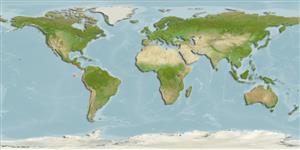Environment: milieu / climate zone / depth range / distribution range
Écologie
marin bathydémersal; profondeur 443 - 528 m (Ref. 40826). Deep-water
Eastern Pacific: off Gulf of Panama and Peru.
Taille / Poids / Âge
Maturity: Lm ? range ? - ? cm
Max length : 8.4 cm SL mâle / non sexé; (Ref. 40826)
Rayons mous dorsaux (Total) : 5 - 6; Rayons mous anaux: 4; Vertèbres: 19 - 20. A very small species with entire body with simple, very small, and thickly distributed tubercles. Cephalic lateral-line counts: subopercular usually 6, (5-7); preopercular, 2. Tail lateral-line counts 9-14. Subopercular spines small, inconspicuous. Paired fins moderate length, relatively stout (Ref. 40826).
Life cycle and mating behavior
Maturité | Reproduction | Frai | Œufs | Fécondité | Larves
Bradbury, M.G., 1999. A review of the fish genus Dibranchus with descriptions of new species and a new genus, Solocisquama (Lophiiformes, Ogcocephalidae). Proc. Calif. Acad. Sci. 51(5):259-310. (Ref. 40826)
Statut dans la liste rouge de l'IUCN (Ref. 130435: Version 2024-2)
Menace pour l'homme
Harmless
Utilisations par l'homme
Outils
Articles particuliers
Télécharger en XML
Sources Internet
Estimates based on models
Preferred temperature (Ref.
123201): 7.9 - 8.4, mean 7.9 °C (based on 7 cells).
Phylogenetic diversity index (Ref.
82804): PD
50 = 0.5001 [Uniqueness, from 0.5 = low to 2.0 = high].
Bayesian length-weight: a=0.02344 (0.00968 - 0.05678), b=2.94 (2.73 - 3.15), in cm total length, based on LWR estimates for this (Sub)family-body shape (Ref.
93245).
Niveau trophique (Ref.
69278): 3.3 ±0.5 se; based on size and trophs of closest relatives
Résilience (Ref.
120179): Milieu, temps minimum de doublement de population : 1,4 à 4,4 années (Preliminary K or Fecundity.).
Fishing Vulnerability (Ref.
59153): Low vulnerability (10 of 100).
